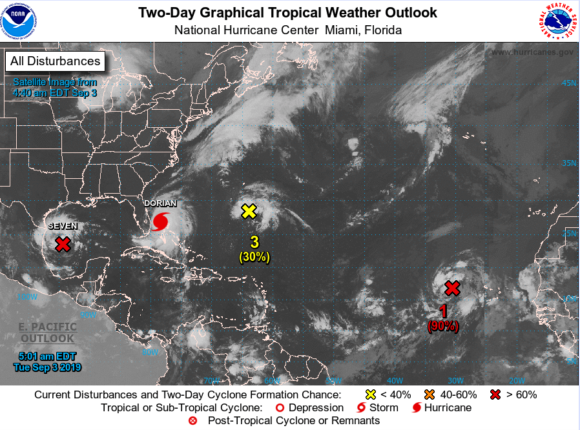Sep 3, 2019, 11:38 AM EST — Hurricane Dorian is on the move once again, inching northwest and potentially up the U.S. East Coast after bashing the Bahamas for almost two days with high winds and driving rains that have inflicted huge damage, killing five on one island alone.
The storm is now traveling 2 miles per hour with sustained winds of 110 miles (177 kilometers) per hour, dropping it to Category 2 status, the National Hurricane Center said at 11 a.m. New York time. Dangerous winds and a life-threatening storm surge continue to savage Grand Bahama Island.
Meanwhile, Dorian is growing in size, with hurricane-force winds extending some 60 miles from the eye, compared with 45 miles previously, the center reported. It is forecast to move “dangerously close” to the Florida coastline as soon as Wednesday, inundating it with rain, rising sea levels and a storm surge as it travels north toward Georgia and the Carolinas.
“Today is ‘moving day’ for Dorian as the northward turn has finally commenced,” said Todd Crawford, lead meteorologist at The Weather Co., an IBM business, in a telephone interview.
As a result, storm surge and hurricane warnings have now been extended into South Carolina, and a hurricane watch has been issued for parts of North Carolina’s coast. In Florida, several surge warnings and hurricane watches have been canceled south of the Jupiter Inlet.
“Florida will likely dodge the worst impacts,” Crawford said, “although coastal areas will have long stretches of tropical-storm force winds later today and tomorrow.”
Shoreline residents and businesses in Florida, Georgia and the Carolinas have already been ordered by their respective state governments to evacuate. Crawford said he hasn’t yet ruled out the chance of landfall north of Florida.
“We know that these evacuations are inconvenient, difficult and sometimes costly,” North Carolina Governor Roy Cooper said in a statement. “But we must realize the potential deadly cost of refusing to evacuate when told.”
Meanwhile, the Bahamas continue to be under attack.
“I don’t think there has been a populated area in the entire Atlantic basin in the climatological record that has experienced the severity and the intensity of impacts that Grand Bahama Island and Abaco have experienced in the past two days,” said Ryan Truchelut, president of Weather Tiger in Tallahassee, Florida.
Dorian is weakening in part because it has exhausted its supply of warm ocean water by sitting over the same spot for days, Truchelut said. He doesn’t see the storm — pulled along by a low pressure system — moving much farther west, with the core of the hurricane likely staying about 75 miles off of Florida. But he said the eastern North and South Carolina are still very much at risk.
“The story of Dorian will be written in two parts,” The Weather Co.’s Crawford said. “First, the utter devastation and humanitarian crisis in parts of the Bahamas and, second, the surprise major impacts in the Southeast and Northeast U.S.”
Winds that occur in the coastal areas of the Carolinas, mid-Atlantic, and even Cape Cod, may end up being stronger than what Florida will get, he said.
Dare County, North Carolina, which includes much of the tourist-friendly Outer Banks, issued a mandatory evacuation for visitors starting Tuesday and for residents beginning Wednesday. Other parts of the state’s coastline were also bracing for the storm. Ocean-going commercial vessels and barges greater than 500 gross tons should make plans for departing North Carolina ports, the U.S. Coast Guard said in a statement early Tuesday local time.
While the current forecast keeps Dorian’s center offshore, forecasters are keeping a close eye for changes, according to Ken Graham, the hurricane center’s director. “It doesn’t take much, a little wobble, a little wiggle and you have hurricane-force winds on shore,” he said in a Facebook update.
Grand Bahama, one of the island nation’s northernmost centers, remains near the center of the storm, which has caused widespread flooding in many of the islands of the northwest and central Bahamas, the National Emergency Management Agency has said. Parts of the northern Bahamas are in the “midst of a historic tragedy,” Prime Minister Hubert Minnis said in a post on Twitter.
Based on reports out of Abaco, one of the first islands to be hit, “the devastation is unprecedented,” he said. On Tuesday, the Bahamas government sent out an “urgent plea” asking owners of boats and jet skis to help out with post-hurricane rescue operations for residents stranded by flood waters.
The damage to some of the region’s large tourist hotels will likely hit revenue in a country where tourism accounts for about half of gross domestic product, said Andrew Stanners, investment director for Aberdeen Standard Investments, which owns the nation’s dollar bonds. The Bahamas has recently taken “strident steps” to improve government finances, which leave it better placed to repair the devastation, he said.
There are also two major petroleum terminals in the Bahamas. Buckeye Partners LP, which operatesa large crude and refined products terminal at Freeport, roughly 100 miles from the Florida coast, shut its facility, according to Robert Malecky, executive vice president of Buckeye GP. The terminal, which is able to handle oil supertankers, has a capacity of 26 million barrels of crude, gasoline and diesel.
Equinor ASA has a terminal in nearby South Riding Point with a storage capacity of 6.75 million barrels of crude and condensate. The facility was in the process of shutting its terminal ahead of Dorian, according to the company said.
Dorian will cause at least $25 billion of insurance losses, according to analysts at UBS Group AG, the costliest of any natural disaster since 2017. Depending on whether it hits the eastern coast of Florida in the next few days, the storm could cost as much as $40 billion, they said.
NextEra Energy Inc.’s Florida Power & Light utility has restored electricity service to roughly 60,000 customers as Dorian neared the coast, chief communications officer Dave Reuter told a Monday morning press conference. Much of the damage, he said, had come from vegetation or wind-borne debris hitting power lines. “We are still not in the clear,” Reuter said.
The FPL website showed 3,330 customers without power as of 11:17 a.m. Tuesday.
Topics Catastrophe Natural Disasters Florida Windstorm Hurricane North Carolina
Was this article valuable?
Here are more articles you may enjoy.



 AIG Partners With Amwins, Blackstone to Launch Lloyd’s Syndicate Using Palantir
AIG Partners With Amwins, Blackstone to Launch Lloyd’s Syndicate Using Palantir  Hacking Group ‘ShinyHunters’ Claims Theft of Data From Users of Pornhub
Hacking Group ‘ShinyHunters’ Claims Theft of Data From Users of Pornhub  North Carolina Sting Operation Alleges Roofer Damaged Shingles to File Claim
North Carolina Sting Operation Alleges Roofer Damaged Shingles to File Claim  Three Top P/C Insurers Account for Most of Insurance AI Patents
Three Top P/C Insurers Account for Most of Insurance AI Patents 

